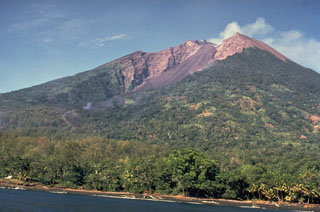Report on Manam (Papua New Guinea) — March 1993
Bulletin of the Global Volcanism Network, vol. 18, no. 3 (March 1993)
Managing Editor: Edward Venzke.
Manam (Papua New Guinea) Activity continues at very low level
Please cite this report as:
Global Volcanism Program, 1993. Report on Manam (Papua New Guinea) (Venzke, E., ed.). Bulletin of the Global Volcanism Network, 18:3. Smithsonian Institution. https://doi.org/10.5479/si.GVP.BGVN199303-251020
Manam
Papua New Guinea
4.08°S, 145.037°E; summit elev. 1807 m
All times are local (unless otherwise noted)
"Activity . . . continued at a very low level throughout March. During the month's first and last weeks, when the summit area was clear, emissions from both craters consisted of thin white vapours being released at a weak-to-moderate rate. No night glow was reported. There was a report of acid rainfall 12 March on the upper slopes SE of the summit. Seismicity throughout March consisted of discontinuous low-amplitude tremor and small low-frequency events. Tilt measurements showed no trends."
Geological Summary. The 10-km-wide island of Manam, lying 13 km off the northern coast of mainland Papua New Guinea, is one of the country's most active volcanoes. Four large radial valleys extend from the unvegetated summit of the conical basaltic-andesitic stratovolcano to its lower flanks. These valleys channel lava flows and pyroclastic avalanches that have sometimes reached the coast. Five small satellitic centers are located near the island's shoreline on the northern, southern, and western sides. Two summit craters are present; both are active, although most observed eruptions have originated from the southern crater, concentrating eruptive products during much of the past century into the SE valley. Frequent eruptions, typically of mild-to-moderate scale, have been recorded since 1616. Occasional larger eruptions have produced pyroclastic flows and lava flows that reached flat-lying coastal areas and entered the sea, sometimes impacting populated areas.
Information Contacts: H. Patia, R. Stewart, and C. McKee, RVO.

